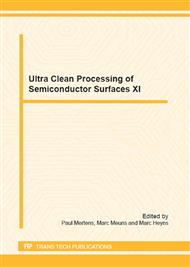p.289
p.293
p.297
p.301
p.305
p.310
p.314
p.318
p.321
Improved Surface Cleaning by In Situ Hydrogen Plasma for Amorphous/Crystalline Silicon Heterojunction Solar Cells
Abstract:
In future, thin wafers (< 100µm) will be employed in silicon heterojunction solar cell to decrease modules cost-per-Watt-Peak. However, in order to maintain excellent cell efficiency a higher device surface/volume ratio will demand stricter requirements on surface passivation. In this frame, the status of the crystalline surface (c-Si) prior to amorphous silicon (a-Si:H(i)) plasma deposition (PECVD) plays an important role: the c-Si chemical termination influences the quality of the interface layer a-Si:H(i)/c-Si, and affect the open circuit voltage (Voc). Previous studies have shown that smooth and fully hydrogenated c-Si surface [ lead to best quality heterojunction. These surfaces can be obtained by different wet cleaning procedures, usually terminated by an immersion in diluted HF. However, after this step, the wafer surface is highly reactive and can re-oxidize rapidly: contaminants presents in air can be adsorbed and affect wafer passivation [. For this reason, in-situ Hydrogen (H2) plasma cleaning prior to a-Si:H(i) deposition might be an interesting option to decrease the amount of contaminant on the surface. However, the experimental window is extremely narrow, since phenomena like epitaxial growth and ion-bombardment damage can easily occur [[ and worsen the surface passivation operated by a-Si:H(i) layers. In this contribution, we present an in-situ H2 plasma clean and show a decrease of Oxygen and Carbon on wafer surface after a short time (<10 sec), without detrimental effects on the subsequent passivation.
Info:
Periodical:
Pages:
321-323
Citation:
Online since:
December 2012
Price:
Сopyright:
© 2013 Trans Tech Publications Ltd. All Rights Reserved
Share:
Citation:



